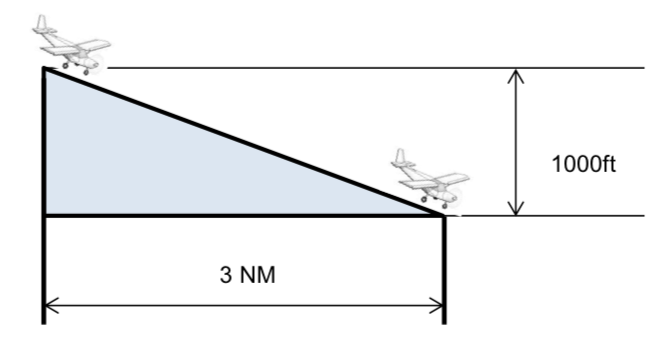¶ Introduction
The top of descent or TOD is the point for an aircraft to initiate a descent to a lower lever for arrival at the destination airfield. The aircraft is leaving the cruise phase of the flight and start a descent phase to the first approach altitude expected over an aerodrome circuit, a landmark or entry VFR points.
¶ Angle of descent rate
The standard descent is calculated along a 3° descent angle :
➣ Descent angle (°) / descent rate (%) x 0.6
➣ Rate (ft/NM) / 60 x Rate (%) ➔ 1% descent rate = 60ft/NM
➣ Rate (ft/NM) / 100 x Rate (°) ➔ 1° descent angle = 100ft/NM
¶ Rule of 3
In aviation, pilots adopted a formula to assure a slow, based on a 3° descent rate, steady and comfortable descent: the rule of three or "3:1 rule of descent".
This rule implies 3 NM of travel should be allowed for every 1,000 feet (300 m) of descent.
The "rule of 3" is used by pilots flying small aircraft as well as by those flying airliners.

¶ Top of descent (TOD) calculation
¶ Top of descent calculation (for light VFR)
For a light VFR aircraft, the usual descent rate can be taken as -500ft/min. That means you will lose 500ft in 1 minute.
Using this rate in feet/min, you can easily calculate the top of descent time.
Time_before_arrival (min) = (Altitude to loose /descent_rate (ft/min)
Example: An aircraft is at 3500ft and I need to join the aerodrome circuit at 1500ft. Aircraft needs to loose 2000ft and will use -500ft/min vertical speed. Time before arrival = 2000/500 = 4 min. The pilot now knows that he must start his descent 4min before joining the circuit. (In order to make a quick calculation, round your altitude to the nearest 500ft. (example: for 3300ft, you will take 3500ft))
For a light VFR aircraft, the usual cruising speed is around 120kt. That means, you travel 2NM each minute or 30 seconds flight each 1NM.
If the pilot wants the distance calculation, we can use this basic calculation
Factor (min/NM) = 60/TAS -> Factor_inv (NM/min) = TAS/60 Distance = Factor_inv x Time_before_arrival
If the aircraft altitude is low (below 5000ft), you can take the approximation TAS = IAS.
Example: The pilot knows that he must start his descent 4min before joining the circuit, his altitude is 3500ft and speed 120kt Distance = (120/60) x 4 = 8 NM The pilot shall start about 8NM from the circuit or destination airfield.
¶ Distance based top of descent calculation
A more complex calculation can be used for VFR flight using aircraft which can fly at an altitude over FL100 and/or the speed is greater than 150kt.


Example: We are flying at 5500ft We need to descent to next point at 1500ft at standard rate 3°.
D (NM) = (5500-1500)/100 / 3° = 40/3 = 13.3 NM Result is that we shall start the descent around 13NM before the expected point.
¶ Descent rate calculation
If you want to descent using a 3° descent path and you expect a vertical speed in feet per minute to set the value on your autopilot panel, you must use the calculation below using the ground speed.
Vertical speed (ft/min) = Descent rate (%) x Ground speed (knots)
Example: Ground speed is 110kt, and descent rate is standard 5%. Note that the descent rate value can be approximated using only 5% instead of 5.2% to ease the calculation. Vertical speed = 5 x 110 = 550ft/min, (if we use 5.2% instead, vertical speed will be 572 ft/min -> less than 5% error).
But this formula has some restrictions:
- Ground speed in some aircraft is not known because the wind is not known
- Ground speed can change during descent if this speed is not maintained constant.
You need to estimate your ground speed for this calculation.
- None
- None
- VID 150259 - Creation
- VID 450012 - Wiki Integration
- VID 496402 - Wiki.js integration